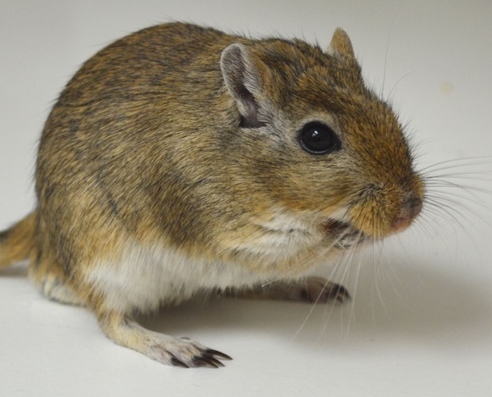
March is just about over and it’s time to say good-bye to the gerbil who was our Animal of the Month. If you were following us on Twitter @ExoticPetVets, you will have seen our tweets about these friendly and engaging animals. Here’s a summary if you missed any of our tweets. Did you know?:
- There are about 110 different gerbil species, but a Mongolian species (Meriones unguiculatus) is the most common pet.
- In the wild, gerbils live in arid parts of Asia, the Middle East and Africa, and were once referred to as “desert rats.”
- Importing gerbils is banned in New Zealand, Australia, California and Hawaii on concerns they threaten local ecosystems.
- Gerbils typically have light-coloured bellies, but their coats have many colours, including brown, black, white and grey.
- The lifespan of a gerbil is about 3-5 years.
- Gerbils are good family pets if socialized from a young age.
- Gerbils are territorial, but can live in pairs peacefully if they’re introduced at a young age and have enough space.
- Male and female gerbils can form bonded pairs before eight weeks of age. Once they’re bonded, they shouldn’t be separated.
- Gerbils engage in a behaviour called foot-drumming.
- Gerbils will foot-drum to communicate with each other or when they’re scared or excited.
- Gerbils don’t shed very much and don’t appear to be pets that trigger allergic reactions in people.
- Gerbils are clean and because they originate from the desert, they don’t drink or urinate as much as other rodents.
- Gerbils are friendly, active and curious and can be trained to sit on your shoulder.
- Gerbils can be a challenge to hold as they tend to scamper about.
- Never pick up gerbils by the tail as it could break or deglove, meaning the fur and skin are torn off the tail.
- This degloving injury (a.k.a. a tail slip) is an adaptation of the gerbils’ anatomy that helps them escape from predators.
- To pick up gerbils safely, use two hands to scoop them up from underneath.
- Gerbils are hardy and disease-resistant animals, but should see a vet for a check-up once or twice a year.
- Gerbils are unique among rodents as they’re the only ones who can have epileptic seizures.
- A gerbil’s epileptic seizures are believed to be triggered by fright or by blowing in the gerbil’s face.

